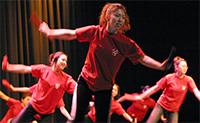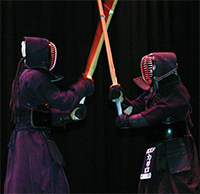Amerasia week celebrates culture
By NYRIE KARKAZIAN
Different Asian communities had a chance to spread cultural diversity
throughout Fresno State last week with their annual Amerasia week.
The Amerasia group, which presented the six-day festival, celebrated its
35th year with showcases each night put on by different Asian cultures.

(above) Mieko Tanaka performs an Asian dance during the Amerasia
week event at the Satellite Student Union. (below) Kendo, the formal
art of Japanese swordsmanship, was demonstated during the Amerasia
week. Photos by Joseph Vasquez

|
The events ran from Feb. 28 through Saturday in the Satellite Student
Union.
The week started off with a comedy night on Feb. 28 featuring guest stand-up
comic Eliot Chang and ended with a festival Saturday night.
The rest of the week included Cambodian culture night, open mic night,
Southeast Asian Night, Japanese Night and Hmong culture night.
“Asian culture is more than martial arts and Chinese food,”
said Chong Her, president of the Amerasia club. “The cultural makeup
in Asia is varied and diverse, just like the Asian community here in Fresno.”
All the nights were filled with singing, dancing and cultural performances
from many different groups.
Thursday night for example was Southeast Asian and Japanese culture night.
The night began with an introduction into Japanese sports for the first
hour.
Both sumo wrestling and kendo fighting were demonstrated. The sumo wrestling
was illustrated by two men who came out on stage wearing inflated sumo
outfits.
Kelly Moody, a senior majoring in liberal studies, said the wrestling
was hilarious.
The wrestlers kept falling over as they engaged each other because their
costume was large.
A group of about 10 people had to come on-stage and pick them up everytime
they fell.
Moody said they demonstrated different fighting skills, such as slapping
each other all over the body and pushing their opponent over from behind.
“I think it was really interesting,” Moody said. “It’s
something I’ve never seen, something you don’t see every day.”
The rest of the hour consisted of a fighting technique called kendo, the
sports version of samurai fighting. The performance featured two men dressed
from head to toe in black robes demonstrating fighting skills with hardwood
swords. During every move and with each thrust the fighters would shout.
The noises were later described as the fighting spirit, and the words
are shouted out because each person must call out their strike before
attacking.
“This is all that is left of samurai fighting,” said Harim
Martinez, the webmaster and graphic designer for Amerasia.
Martinez said kendo classes were available on campus.
He also said the outfits worn in these fights and competitions are very
intricate and heavy and expensive. One outfit alone can start at $1,000,
and the helmet itself weighs about 30 pounds.
Martinez has been a part of Amerasia for three years and said that last
year the festivities averaged about 350 people per weeknight.
The event attracted people from all parts of California; -- from San Francisco
all the way to San Diego.
“So far we have actually had better attendance than last year,”
Martinez said on Thursday night.
Martinez said the week starts out with a younger crowd but becomes more
diverse toward the end. The biggest night of the week is Saturday night,
which is festival night.
“It’s really loud and festive; it’s a fun atmosphere,”
Martinez said. “The music, drums and everything goes by so fast,
it doesn’t feel like two hours has gone by.”
He said the festival had so much responses this year, they had to turn
away many performance group.
They also turned away three bands and four performers on open mic night
alone.
Kia Lee, Amerasia week co-chair, said they try to allow each of the organizations
on campus a chance to participate. Some of the groups on campus are the
Japanese Students Association, Southeast Asian Teachers Association, Hmong
Student Association and the FSU Lion Dance group.
Lee said the week is to show culture and diversity among the Asian community
and all others who are interested in the beautiful and fascinating culture.
“There are a lot of skits and interesting dances; it’s fun,”
Lee said.
|
